 Although the Sun is 150 million kilometers away, the sudden expulsion of particles and gas that we see in solar flares and coronal mass ejections can have a strong effect on the Earth. This intimate connection between physical processes at the Sun and changes in the Earth's magnetic environment has been dubbed Space Weather.
Although the Sun is 150 million kilometers away, the sudden expulsion of particles and gas that we see in solar flares and coronal mass ejections can have a strong effect on the Earth. This intimate connection between physical processes at the Sun and changes in the Earth's magnetic environment has been dubbed Space Weather.
One of the more benign consequences of Space Weather is the aurorae, which we know better as the Northern and Southern Lights. A bright aurora signifies a strong disturbance in the upper atmosphere and magnetic field of the Earth. However, much of what we call Space Weather is invisible to the naked eye and can have much more severe consequences.
The average coronal mass ejection colliding with the Earth results in an additional 1500 Gigawatts of electricity being added to the atmosphere: this is equivalent to twice the power generating capacity of the whole United States.
Strange terrestrial electrical effects have been related to events on the Sun for a little over 100 years. But it is only in the last decade or so that our reliance on the technology of satellite communications (cell phones, pagers and the like), high altitude flights, and long-term manned space exploration, that the effects of solar storms have become important to society at large.
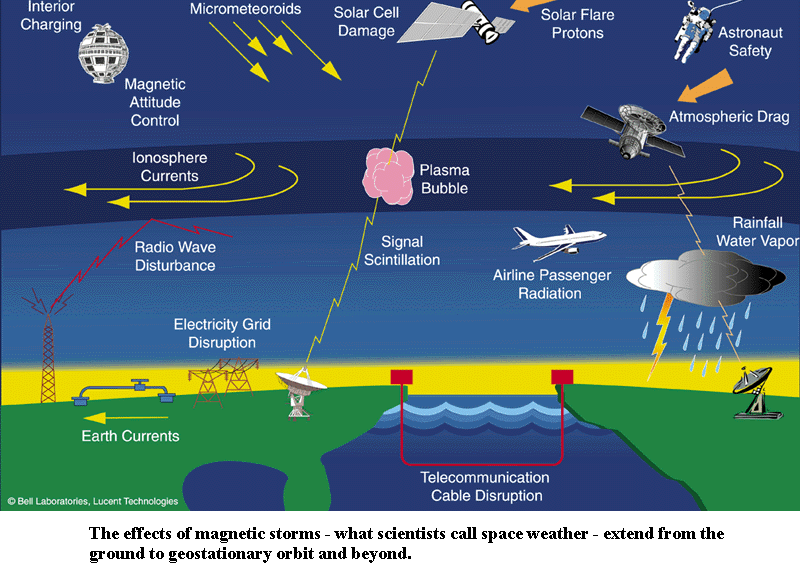
Solar storms are known to be responsible for some major electrical disruptions and satellite failures:
- 1972: A 230,000 volt transformer at the British Columbia Hydroelectric Authority blew up during the storm of August 2.
- 1982: A marine navigational satellite, Marecs-B, was disabled during a week of intense auroral activity in February of this year.
- 1989: Quebec was plunged into a full-scale power blackout during the March 13 storm affecting 6 million people for nine hours. A transformer also burned up at a New jersey power station
- 1989: The same storm in March caused a strange effect in Minnesota: they were unable to pick up their local radio stations but could hear the broadcasts of the California Highway Patrol.
- 1994: Two Canadian satellites were shut down when each was electrically shocked during magnetic storms; resulting in a disruption to telephone service which lasted for months.
- 1997: An American satellite, AT&T Telstar 401, went dead on January 11 just hours after a CME struck the Earth's magnetosphere, causing problems with television signals, telephone calls, and part of the US earthquake monitoring network.
- 2002: the Nozomi Mars Probe was hit by a large Solar Energetic Particles event which caused large-scale failure. The mission, which was already about 3 years behind schedule, was eventually abandoned in December 2003.
 Satellites are particularly vulnerable to the electrical effects of Space Weather as they are buffeted by the incoming gas and radiation. There is also a less obvious but equally costly effect to satellites in near-Earth orbits, caused by the increased radiation hitting the Earth's atmosphere.
Satellites are particularly vulnerable to the electrical effects of Space Weather as they are buffeted by the incoming gas and radiation. There is also a less obvious but equally costly effect to satellites in near-Earth orbits, caused by the increased radiation hitting the Earth's atmosphere.
The extra energy of charged particles and ionizing radiation causes the atmosphere of the Earth to expand, which, in turn, creates extra drag on the satellites orbiting the Earth. It is estimated that more than 1500 satellites slowed in their orbit or lost several kilometers of altitude as a result of the great storms of March 1989.
The effects of solar storms on the ground can also be expensive. Magnetic storms can change the Earth's magnetic field producing surges in power lines and long uninterrupted oil and gas pipelines. The extra current in the power lines can burn out transformers, leading to large-scale brownouts or blackouts, while the electricity in pipelines can enhance the rate of corrosion. It is estimated that transformer failures across the US and Canada cause $100 million in equipment damage each sunspot cycle!
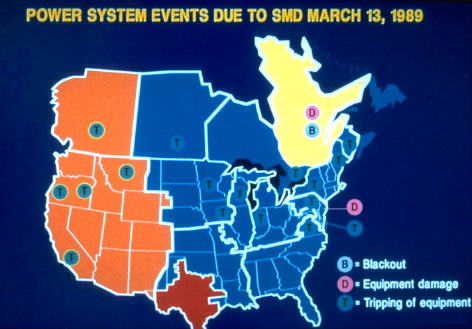
A map of North America showing the various electrical service problems recorded during the March 13 1989 storm.
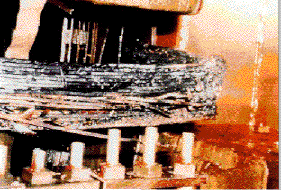
PJM Public Service Step-Up Transformer: Severe internal damage caused by the space storm of March 13 1989.
Both images from
IMAGE/POETRY website.
These days, not long past the beginning of the 21st century, we are all very familiar with space; some of you may even be thinking of a future vacation on a space shuttle or a quick 90-minute cruise around the globe. As our physical presence in space increases, we need to be more aware of the dangers that solar storms can present. While the International Space Station was being built, construction required that astronauts were out in open space for considerable lengths of time. With not warning system, if a solar flare or CME occured during one of their space walks, the radiation received by that astronaut could have easily exceeded her permitted yearly dosage, effectively grounding her for 12 months.
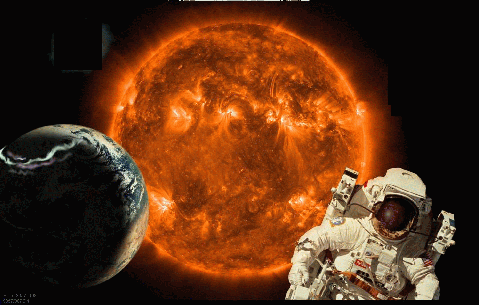
How do you prevent all of the above from happening? We can't tell the Sun what to do or when to do it. Just like on Earth, nature always wins. The best we can do is to protect ourselves and our sensitive electronic equipment when we know a storm is approaching. When residents of coastal Florida receive a warning that a hurricane is heading their way, they batten down the hatches, secure their possessions and head for the hills (so to speak). NASA's Space Weather Initiative is set up to provide as much early warning as possible so that power station technicians, satellite operators, astronauts, airplane flight crews and the like can take proper precautions. For instance, with enough advance warning, an astronaut could get back inside the shielded area of the space shuttle, or a satellite operator can perhaps switch off sensitive equipment during the storm.
Some of the best defenses against the effects of storms come in the early design stages, especially of satellites. By adding radiation shielding to sensitive electronics much of the damage of solar storms can be avoided. This is costly, but in some cases worth the additional expense.
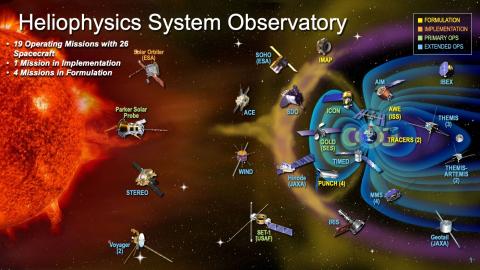 A network of solar observing stations around the globe and in space are used to constantly monitor the behavior of the Sun, providing a measure of predictive capability for solar storms. Like its counterpart on the Earth, Space Weather is a complicated system and making forecasts can sometimes be hit or miss. As we learn more about the physical processes behind the production of solar flares and coronal mass ejections our ability to forecast potentially dangerous disruptions will improve. We are in space for good now, and like sailors of old, we will need to 'weather the storm.'
A network of solar observing stations around the globe and in space are used to constantly monitor the behavior of the Sun, providing a measure of predictive capability for solar storms. Like its counterpart on the Earth, Space Weather is a complicated system and making forecasts can sometimes be hit or miss. As we learn more about the physical processes behind the production of solar flares and coronal mass ejections our ability to forecast potentially dangerous disruptions will improve. We are in space for good now, and like sailors of old, we will need to 'weather the storm.'
For a look at today's Space Weather forecast visit spaceweather.com
This video from Seeker features Solar Week scientist Dr. Delores Knipp and explores some of the impacts that space weather can have on Earth.
Back to today's topic